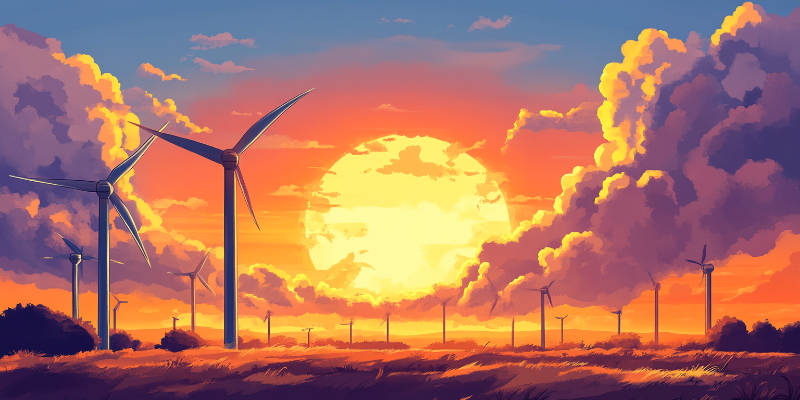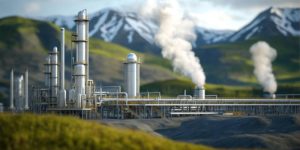Wind Turbines and Their Impact on Weather. Blocking Sunlight.

Wind energy is often presented as a clean and sustainable solution for energy needs. However, the impact of wind turbines on local and even global weather is rarely discussed. Recent studies indicate that large-scale wind farms can cause significant changes in temperature, humidity, and wind patterns. This raises the question: to what extent do wind turbines actually affect our climate, and what are the broader implications?
How Wind Turbines Influence Local Climate
Turbulence and Temperature Changes
Wind turbines extract energy from natural wind flows and create turbulence in the atmosphere. Research published in Nature Climate Change (2018) shows that this turbulence causes mixing between lower and higher air layers, which can lead to increased surface temperatures, especially at night. This effect has already been observed in parts of the United States and China, where temperature increases of 0.5 to 1.5 degrees Celsius have been recorded around wind farms (Zhou et al., 2012).
In the Netherlands, a study by the KNMI (2021) found that wind turbines can influence local weather systems, particularly in coastal areas where wind energy is widely generated. This may have consequences for agricultural production and local ecosystems.
Impact on Precipitation and Humidity
Wind farms can also affect the moisture content of the air. Research from the University of Illinois (2019) indicates that wind turbines increase evaporation from water surfaces by altering air circulation. In areas with many wind turbines, such as parts of Texas, decreases in air humidity and increases in evaporation have been documented.
For the Netherlands, with its many offshore wind farms, this effect could potentially influence rainfall and storm formation along the coast. This might result in drier summers or more intense rainfall, depending on how wind patterns change.
Blocking Sunlight and Its Effect on Microclimates
A less discussed effect of wind turbines is their impact on sunlight and shadow casting. Wind turbines create moving shadows, a phenomenon known as “shadow flicker,” which can affect both human environments and natural ecosystems. Research from the Renewable Energy Journal (2021) suggests that large wind farms can reduce solar radiation on nearby farmland, affecting photosynthesis and thereby lowering crop yields.
Additionally, the blocking of sunlight can influence local temperature, especially during morning and evening hours. A study by the Fraunhofer Institute (2022) found that the shadow patterns of wind turbines can amplify temperature differences in certain areas, causing minor microclimate changes.
Wind Turbines and Cloud Formation
An interesting effect of large-scale wind farms that has been explored in recent research is their potential to alter cloud formation. The turbulence caused by wind turbines, especially in large farms, can disrupt atmospheric stability and may lead to changes in cloud cover. Some studies suggest that the mixing of air layers, in addition to creating localized temperature increases, can also influence cloud formation patterns, potentially leading to increased cloudiness or changes in cloud types. This could, in turn, impact local weather, including light conditions and the formation of storms.
A study conducted by the University of Cambridge (2020) explored the relationship between wind farms and cloud cover, particularly in regions with extensive wind farm development. The findings indicated that wind turbines could slightly alter the timing and density of cloud formations, particularly in areas where they are placed in clusters. These changes could contribute to regional weather shifts, including changes in sunshine hours and microclimate conditions.
Effects on Regional and Global Wind Patterns
Disruptions in Wind Flows
Wind turbines extract energy from the wind, meaning large-scale wind farms could potentially affect regional and even global wind patterns. A study in Scientific Reports (2020) found that large wind farms can reduce wind speeds at lower levels, disrupting natural airflow. This can lead to a decline in wind energy further downwind, making other wind farms less effective.
Dutch scientists have studied this effect in the North Sea, where wind turbines may impact the stability of air currents that drive storms. A study by TNO (2022) suggests that large offshore wind farms can alter wind direction and speed in adjacent areas.
Consequences for Ecosystems and Agriculture
These disruptions can also affect agriculture and natural ecosystems. Less wind means less natural air circulation, which can lead to stagnant air and potentially higher concentrations of air pollution. Some studies have also suggested that altered wind patterns may lead to changes in precipitation patterns, impacting agricultural production.
Dutch farmers in Flevoland, for instance, have reported changes in local wind patterns since the installation of large wind farms. This may affect crop pollination and soil moisture evaporation.
Wind Energy and Climate Change: A Sustainable Alternative?
Wind energy is often presented as a solution to climate change, but if wind turbines themselves affect weather patterns, is it still a truly sustainable option? The effects mentioned above are mostly local and regional, but there is evidence that a massive increase in wind farms could cause broader climate disruptions.
Impact on Weather Systems in the Future
Researchers from Harvard University (2018) calculated that if the U.S. were to generate all its electricity from wind, the average temperature in wind farm areas would rise by 0.24°C. This raises questions about the large-scale implementation of wind energy and its potential consequences for global temperature increases.
A Dutch report from the PBL (Netherlands Environmental Assessment Agency) in 2021 suggests that the impact of wind energy on the climate should be further investigated before large-scale expansions are implemented.
Conclusion
Wind turbines provide a energy source, but their influence on weather patterns is a factor that should not be ignored. The turbulence they create can lead to increased temperatures, altered wind flows, and potential effects on precipitation, cloud cover, and agriculture. While wind energy remains a crucial part of the energy transition, it is essential to thoroughly investigate its long-term effects before continuing large-scale wind farm developments.
A more balanced approach that combines wind energy with other sustainable technologies, such as solar energy and geothermal power, could help minimize negative impacts on weather patterns. Further study and monitoring are necessary to ensure that wind energy remains a genuinely sustainable solution.
Sources
- Zhou, L., et al. (2012). “Impacts of wind farms on land surface temperature.” Nature Climate Change.
- Wang, C., et al. (2019). “Influence of wind farms on local hydrometeorology.” University of Illinois Research Papers.
- Miller, L., et al. (2020). “The impact of wind energy extraction on atmospheric dynamics.” Scientific Reports.
- TNO. (2022). “Effects of offshore wind farms on the atmosphere above the North Sea.” Report TNO-2022-Wind.
- Harvard University. (2018). “Large-scale wind power and climate interactions.” Harvard Environmental Research.
- PBL. (2021). “Sustainable energy and climate: Evaluation of the impact of wind farms in the Netherlands.” Netherlands Environmental Assessment Agency.
- KNMI. (2021). “Wind farms and their effect on local weather systems.” Royal Netherlands Meteorological Institute.
- Renewable Energy Journal. (2021). “Shadow effects of wind farms on solar radiation and microclimate.” Renewable Energy Journal.
- Fraunhofer Institute. (2022). “Wind turbine shading and local temperature variations.” Fraunhofer Research Papers.
- University of Cambridge. (2020). “Wind turbines and their impact on cloud formation.” Cambridge Weather Studies.


















